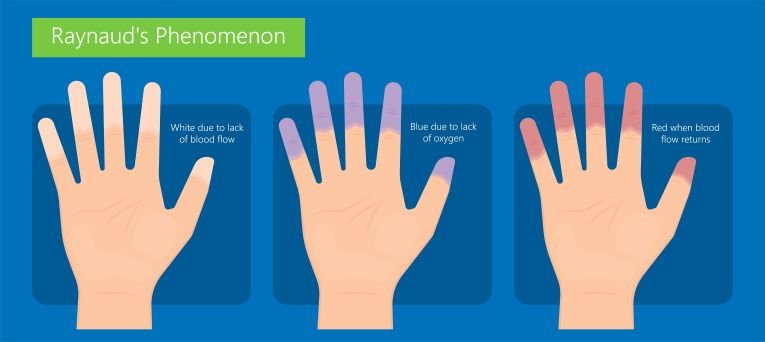Raynaud’s Disease
Raynaud’s Disease (also called Raynaud’s Phenomenon) is a medical condition where the fingers of healthy individuals may become pale in response to severe cold, the effect is exaggerated in individuals.
What is Raynaud’s Disease?
Raynaud’s Disease (also called Raynaud’s Phenomenon) is a medical condition. It is named after the French physician, Maurice Raynaud, who first described it. Although the fingers of healthy individuals may become pale in response to severe cold, the effect is exaggerated in individuals with Raynaud’s symptoms. Even mild cold exposure can cause significant symptoms. 80% of sufferers are women, and as many as 5% of the U.S. population has Raynaud’s disease.
Primary “Raynaud’s Disease” refers to vasospasm (severe, temporary narrowing of the arteries) that happens with cold or stress without any other related medical condition. Some people have other medical illnesses, such as scleroderma or systemic lupus erythematosus. In these cases, “Raynaud’s Phenomenon” is used to describe vasospasm of the digits in response to cold. The cause is not known.
Symptoms
During attacks, the small vessels that supply blood to the skin in the hands, and sometimes the toes, nose or ears constrict, resulting in numbness and a pale or bluish tint.
Diagnosis
Patients are evaluated for other illnesses associated with Raynaud’s phenomenon. These include: connective tissue disorders (lupus, rheumatoid arthritis and scleroderma), vibration injury from the use of power tools, thoracic outlet syndrome and other arterial diseases that compromise blood flow to the hands. Test for secondary Raynaud’s may include non-invasive blood flow studies of the hand and arm, and a blood test called an ANA or rheumatoid factor.
Treatment
The best treatment is to avoid the cause of the attacks. Most individuals can achieve satisfactory control of the frequency and severity of attacks by avoiding cold, using protective garments (including extra layers of clothing: hats, mittens, and warm socks and shoes) or occasionally taking medications that relax the arteries. While a decrease of attacks is achievable, there is no “cure” for Raynaud’s. Some helpful suggestions for Raynaud’s disease include:
Avoid abrupt changes in temperature, especially going from warm air to air conditioning
Do not go outside without a coat, hat or mittens
Use mittens to take anything out of the freezer
Do not smoke
Prevention
Some helpful suggestions for Raynaud’s phenomenon:
Keep your hands from getting cold
Do not use vibrating tools
Wear mittens instead of gloves
Avoid excessive stress
See your doctor if you get worse or if you notice a finger sore
Risk Factors
Affects more women than men
Occurs more commonly in youth (between ages 5 and 35 years)
May occur more frequently in members of the same family
Resources
Be The Voice For Patients Like You!
Vascular Cures is inviting patients and advocates to share their stories, advise on our programs, and help us advocate for patient needs. Patients as Partners is a community where patients are heard, empowered, and encouraged to impact the health system. Learn more and request more information here.


